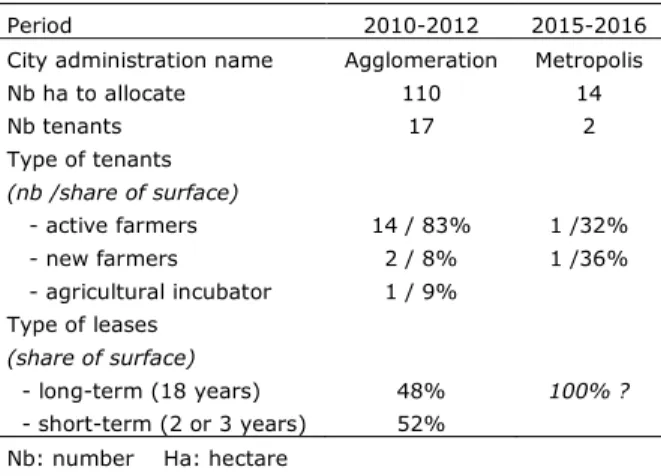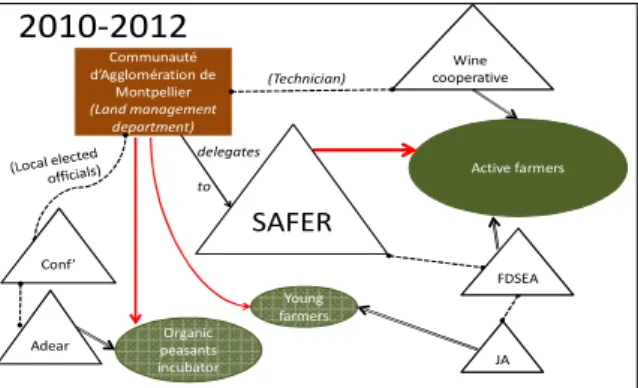HAL Id: hal-02738337
https://hal.inrae.fr/hal-02738337
Submitted on 2 Jun 2020
HAL is a multi-disciplinary open access
archive for the deposit and dissemination of
sci-entific research documents, whether they are
pub-lished or not. The documents may come from
teaching and research institutions in France or
abroad, or from public or private research centers.
L’archive ouverte pluridisciplinaire HAL, est
destinée au dépôt et à la diffusion de documents
scientifiques de niveau recherche, publiés ou non,
émanant des établissements d’enseignement et de
recherche français ou étrangers, des laboratoires
publics ou privés.
Allocation of public land to farmers: a way to support
multifunctional agriculture on the urban fringe?
Nabil Hasnaoui Amri, Coline Perrin
To cite this version:
Nabil Hasnaoui Amri, Coline Perrin. Allocation of public land to farmers: a way to support
multi-functional agriculture on the urban fringe?. AESOP Sustainable food planning Workshop ”Making,
Measuring, Rethinking sustainable food systems”, Association of European Schools of Planning
(AE-SOP). FRA., Mar 2017, Berlin, Germany. 58 p. �hal-02738337�
AESOP Workshop
Berlin March 23-24
th
Sustainable Food Planning
1
Allocation of public
land to farmers:
a way to support
multifunctional agriculture on
the urban fringe?
Nabil HASNAOUI AMRI, Coline PERRIN
1Abstract –This paper examines how city councils
progressively engage in the promotion of
multifunctional periurban agriculture. It relies on a document analysis and interviews within Montpellier metropolis (France). We compare and assess two procedures of public farmland allocation, and explore the conditions for an improved dialogue between urban and agricultural stakeholders.
Keywords – farmland management; urban agriculture; land access; public policies; governance.
Preferred session: Making sustainable food planning. INTRODUCTION
In a context of increased urban demands for food and environmental, recreational and landscape-related services in the Global North, city councils express a willingness to preserve farmland and support multifunctional periurban agriculture (PUA). However, farmers on the urban fringe often struggle to access to land because of three main constraints: urban sprawl; increasing land prices; and frequent land retention by owners (who prefer to keep their parcels unfarmed, awaiting their possible conversion to urban uses).
In this context, can allocation of public land be a driver to support farmers’ access to farmland and to allow a transition towards a more ecological farming and more local food networks? Such allocations have been recently relaunched by various local authorities (regions, municipalities) in France and Italy (Di Donato et al, 2016). However, knowledge is still lacking on how to best conduct such public allocations and on their impacts on PUA.
The aim of this paper is to compare and assess two procedures of public farmland allocation conducted by the Montpellier city council since 2010. Have these initiatives stimulated a transition to a greener type of farming and to a more local food supply? Which lessons can be learned by policy makers concerning these procedures?
The Montpellier region has experienced a rapid demographic growth since 1960. Suburban sprawl has extended into the former vineyards. The decline of the wine industry has freed up land for other types of farming: forage cultivation, cereal crops and
1 Nabil HASNAOUI AMRI and Coline PERRIN are working at
INRA, UMR Innovation, Montpellier, France
(nabil.hasnaoui@supagro.inra.fr; coline.perrin@inra.fr).
more market gardening oriented toward the urban market (Perrin et al., 2013).
Montpellier metropolis is an interesting case study because it has conducted two successive allocations of public land to farmers in very different ways, the first from 2010 to 2012 and the second from 2015 to 2016. It thus offers a unique opportunity to compare different procedures, while the surrounding urban and farming context remains the same.
METHODS
This paper is based on data collected through document analysis (planning documents, minutes of public deliberations, maps produced by the metropolis and the SAFER, a farmers’ organization in charge of monitoring the farmland market) and through interviews (with farmers, government officers and staff). One of the authors has been working for the metropolis since 2015 and was involved in the second farmland allocation. He collected data as a participant-observer.
RESULTS
Two allocations with different scopes
In 2010, the Montpellier agglomeration bought a 192 ha estate and rented 110 ha of cultivable land to local farmers (Table 1). Ten wine growers strengthened their productive capital and received long-term leases. Two young farmers developed conventional market gardening. An incubator for diversified organic agriculture was created. Half of the surface of arable land was allocated to conventional cereal growers via short-term leases.
Table 1. Two successive allocations of public lands
Period 2010-2012 2015-2016
City administration name Agglomeration Metropolis
Nb ha to allocate 110 14 Nb tenants Type of tenants (nb /share of surface) - active farmers - new farmers - agricultural incubator Type of leases (share of surface) - long-term (18 years) - short-term (2 or 3 years) 17 14 / 83% 2 / 8% 1 / 9% 48% 52% 2 1 /32% 1 /36% 100% ?
Nb: number Ha: hectare
In 2015, the Metropolis launched a call for proposals in order to allocate two parcels, imposing social and environmental constraints. Alternative profiles were selected: an organic market gardener and a starting farm coop with multifunctional goals. Both match the agro-ecological transition and are able to provide short food supply chains (SFSC) to the city.
How can we explain such an evolution in four years?
Change in the political context
These two allocations were introduced in very different political contexts.
In 2010, the 192 ha estate was a land opportunity. It was not related initially to any agricultural or food
AESOP Workshop
Berlin March 23-24
th
Sustainable Food Planning
2
plan. This estate was however contiguous to an "agriparc" planned in the 2006 city-region-wide masterplan. In 2011, the Local Agenda 21 program thus included this estate as an experimental site to develop the concept of agriparc, defined as a periurban perimeter where agriculture is protected and multifunctional, combining production, SFSC, landscape and biodiversity management, and leisure and educational activities. Nevertheless, most of the farmers who rented this land in 2012 do not actually contribute to the multifunctional objectives of the agriparc.
In 2014, a new team was elected. In 2015, it launched an "agro-ecological and food policy". The former "Agglomeration" became a "Metropolis" with extended competences in land-use planning and economic development. These two departments conceived a new procedure for farmland allocation, with a call for proposals based on the concept of "nourishing agro-ecology". The applicants were expected to respect organic farming practices, provide SFSC, and welcome city dwellers on farm.
Stakeholders and proceeding changes
The Agglomeration relied on the SAFER farmers’ organization to manage the first allocation. The call for proposals was short (20 days). The SAFER organized a selection committee with mainly conventional farmers, as this organization was historically oriented towards the expansion of existing farms (Sencébé, 2012). Most beneficiaries were thus informed and supported by conventional farmers’ unions (FDSEA, JA, Figure 1). The organic peasants incubator was supported by the peasants' union (Conf') informed by a local elected official. The applicants were not directly consulted before the decision.
2010-2012
Communauté d’Agglomération de Montpellier (Land management department) Active farmers Young farmers Organic peasants incubator delegates to Wine cooperativeSAFER
FDSEA JA Conf’ Adear (Technician)Figure 1. Agricultural and territorial players implied in the first phase
The second allocation process was led directly by the Metropolis with a constant concern for best practices, transparency, and replication. The selection committee was composed of elected officials and technical staff from the Metropolis and from the municipalities where the parcels are located, advised by a local young farmer practicing organic market gardening for SFSC. The selection was based on a weighted criteria list, announced in the call for proposals (open for 4 months), and explained during collective site visits. Each applicant had the opportunity to defend his project directly.
DISCUSSION AND CONCLUSIONS
The first procedure was quick and allowed the allocation of large surfaces to a diversity of farmers. Despite the agriparc framing, it did not reinforce the local weight of agro-ecological and local-food oriented practices. The second procedure was slower, and faced internal administrative lack of know-how and external tensions due to "algorithmic" (Muller, 2000) changes in the allocation process. It opened, however, new opportunities for the city to gain legitimacy in dealing with agriculture and food. Beyond the Metropolis, local private and public players are interested in a process that brings agro-ecology and food on the urban agenda and provides a method to allocate land dedicated to these functions. Such interest shows that these initiatives are territorial innovations (Giraut, 2009), requiring learning processes.
Lessons learned from these initiatives are relevant for local policy makers seeking to take action in favour of farmers’ access to agricultural land. There is no perfect method, but it is crucial to be explicit from the very beginning about the objectives of the allocation, the expected profiles of the applicants and the ways to assess and control them. This transparency increases trust between farmers and the city council, but may also reveal tensions between diverse farming styles and their viability regarding the constraints imposed by the public owner. The renewal of city-agriculture relations underlines the need to explore the conditions for the coexistence of actors in agricultural and urban development.
ACKNOWLEDGEMENT
The authors thank the French National Research and Technology Agency (ANRT) and the Montpellier Mediterranean Metropolis funding via the CIFRE project n°2015/0420; and the French National Research Agency (ANR) funding via the JASMINN project n° ANR-14-CE18-0001.
REFERENCES
Di Donato, B., Perrin, C., Cavallo, A. (2016). Strumenti di gestione dell’agricoltura urbana e periurbana: esperienze a confronto tra Roma e Montpellier, Agriregionieuropa, 12 (44): 59-62. Giraut, F. (2009). Innovation et territoires. Les effets contradictoires de la marginalité. Revue de
Géographie Alpine, 97(1) : 6-10.
Muller, P. (2000). L'analyse cognitive des politiques publiques : vers une sociologie politique de l'action publique. Revue française de science politique, 50e
année, 2: 189-208.
Perrin, C., Jarrige, F., Soulard, CT. (2013). L’espace et le temps des liens ville-agriculture : une présentation systémique du cas de Montpellier et sa région. Cahiers Agricultures, 22(6): 552-558. Sencébé, Y. (2012). La Safer. De l'outil de modernisation agricole à l'agent polyvalent du foncier : hybridation et fragmentation d'une institution. Terrains & travaux, 20(1): 105-120
View publication stats View publication stats

